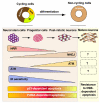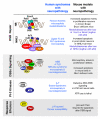Mouse models of DNA double-strand break repair and neurological disease
- PMID: 18458002
- PMCID: PMC3831504
- DOI: 10.1016/j.dnarep.2008.03.007
Mouse models of DNA double-strand break repair and neurological disease
Abstract
The repair of DNA damage is essential for the prevention of disease. The DNA double-strand break (DSB) is a particularly hazardous lesion. DNA DSBs activate a coordinated cellular response involving cell cycle checkpoint activation and repair of the DNA break, or alternatively apoptosis. In the nervous system the inability to respond to DNA DSBs may lead to neurodegenerative disease or brain tumors. Therefore, understanding the DNA DSB response mechanism in the nervous system is of high importance for developing new treatments for neurodegeneration and cancer. In this regard, the use of mouse models represents an important approach for advancing our understanding of the biology of the DNA damage response in the nervous system.
Figures


Similar articles
-
DNA Double Strand Breaks: A Common Theme in Neurodegenerative Diseases.Curr Alzheimer Res. 2016;13(11):1208-1218. doi: 10.2174/1567205013666160401114915. Curr Alzheimer Res. 2016. PMID: 27033054 Review.
-
The DNA double-strand break response in the nervous system.DNA Repair (Amst). 2004 Aug-Sep;3(8-9):1141-7. doi: 10.1016/j.dnarep.2004.03.009. DNA Repair (Amst). 2004. PMID: 15279803 Review.
-
DNA double-strand breaks: a potential therapeutic target for neurodegenerative diseases.Chromosome Res. 2019 Dec;27(4):345-364. doi: 10.1007/s10577-019-09617-x. Epub 2019 Nov 9. Chromosome Res. 2019. PMID: 31707536 Free PMC article. Review.
-
Responding to DNA double strand breaks in the nervous system.Neuroscience. 2007 Apr 14;145(4):1365-74. doi: 10.1016/j.neuroscience.2006.07.026. Epub 2006 Aug 23. Neuroscience. 2007. PMID: 16934412 Review.
-
SIRT6 is a DNA double-strand break sensor.Elife. 2020 Jan 29;9:e51636. doi: 10.7554/eLife.51636. Elife. 2020. PMID: 31995034 Free PMC article.
Cited by
-
Current Evidence for Developmental, Structural, and Functional Brain Defects following Prenatal Radiation Exposure.Neural Plast. 2016;2016:1243527. doi: 10.1155/2016/1243527. Epub 2016 Jun 12. Neural Plast. 2016. PMID: 27382490 Free PMC article. Review.
-
The molecular mechanism of aging and the role in neurodegenerative diseases.Heliyon. 2024 Jan 14;10(2):e24751. doi: 10.1016/j.heliyon.2024.e24751. eCollection 2024 Jan 30. Heliyon. 2024. PMID: 38312598 Free PMC article. Review.
-
Loss of the chromatin regulator MRG15 limits neural stem/progenitor cell proliferation via increased expression of the p21 Cdk inhibitor.Stem Cell Res. 2011 Jul;7(1):75-88. doi: 10.1016/j.scr.2011.04.002. Epub 2011 Apr 25. Stem Cell Res. 2011. PMID: 21621175 Free PMC article.
-
Premature aging-related peripheral neuropathy in a mouse model of progeria.Mech Ageing Dev. 2011 Aug;132(8-9):437-42. doi: 10.1016/j.mad.2011.04.010. Epub 2011 May 11. Mech Ageing Dev. 2011. PMID: 21596054 Free PMC article.
-
Nbn and atm cooperate in a tissue and developmental stage-specific manner to prevent double strand breaks and apoptosis in developing brain and eye.PLoS One. 2013 Jul 30;8(7):e69209. doi: 10.1371/journal.pone.0069209. Print 2013. PLoS One. 2013. PMID: 23935957 Free PMC article.
References
-
- Williams RW, Herrup K. The control of neuron number. Annu Rev Neurosci. 1988;11:423–453. - PubMed
-
- Katyal S, McKinnon PJ. DNA Repair Deficiency and Neurodegeneration. Cell Cycle. 2007;6 - PubMed
-
- McKinnon PJ, Caldecott KW. DNA Strand Break Repair and Human Genetic Disease. Annu Rev Genomics Hum Genet. 2007;8:37–55. - PubMed
-
- Rass U, Ahel I, West SC. Defective DNA repair and neurodegenerative disease. Cell. 2007;130:991–1004. - PubMed
-
- Cleaver JE. Cancer in xeroderma pigmentosum and related disorders of DNA repair. Nat Rev Cancer. 2005;5:564–573. - PubMed
Publication types
MeSH terms
Substances
Grants and funding
LinkOut - more resources
Full Text Sources
Medical

